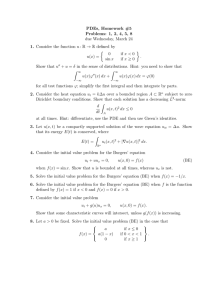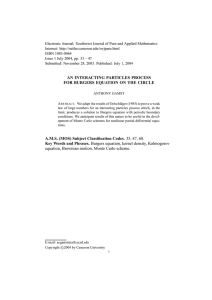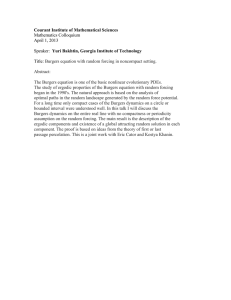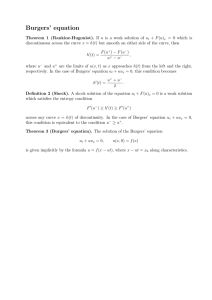THE EQUATION ANALYZING DYNAMICS OF
advertisement
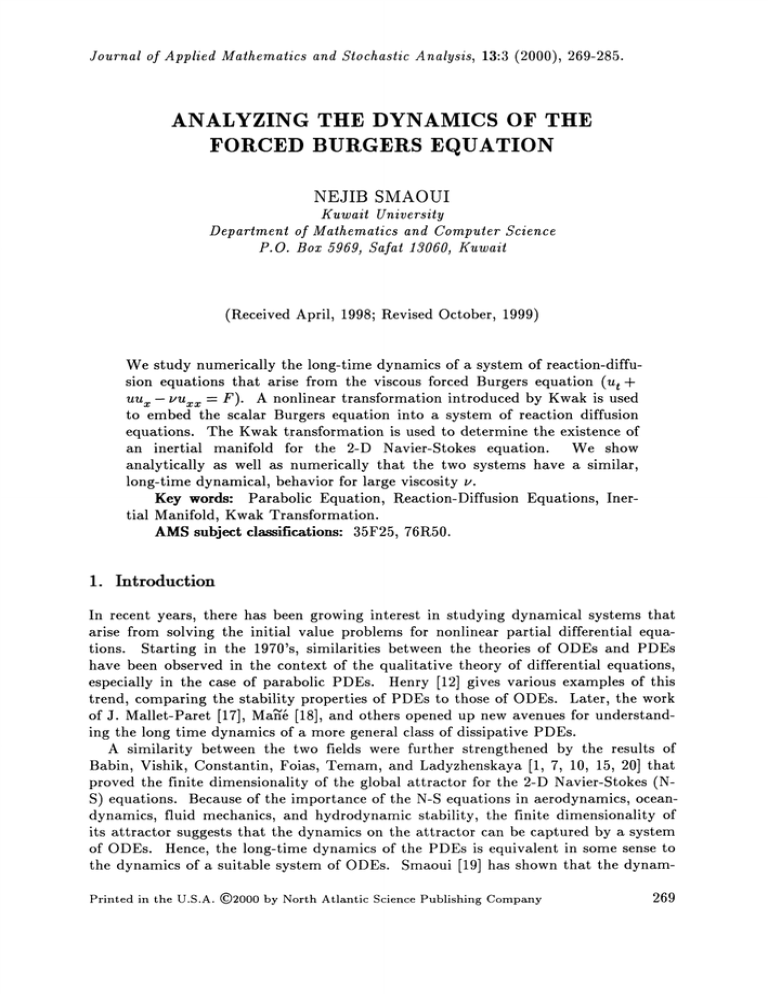
Journal
of Applied Mathematics
and Stochastic Analysis, 13:3
(2000), 269-285.
ANALYZING THE DYNAMICS OF THE
FORCED BURGERS EQUATION
NEJIB SMAOUI
Kuwait University
Department of Mathematics and Computer Science
P.O. Box 5969, Safat 13060, Kuwait
(Received April, 1998; Revised October, 1999)
We study numerically the long-time dynamics of a system of reaction-diffusion equations that arise from the viscous forced Burgers equation (u +
uu x
F). A nonlinear transformation introduced by Kwak is used
to embed the scalar Burgers equation into a system of reaction diffusion
equations. The Kwak transformation is used to determine the existence of
an inertial manifold for the 2-D Navier-Stokes equation.
We show
analytically as well as numerically that the two systems have a similar,
long-time dynamical, behavior for large viscosity u.
Key words: Parabolic Equation, Reaction-Diffusion Equations, Inertial Manifold, Kwak Transformation.
AMS subject classifications: 35F25, 76R50.
-uuxx
1. Introduction
In recent years, there has been growing interest in studying dynamical systems that
arise from solving the initial value problems for nonlinear partial differential equations. Starting in the 1970’s, similarities between the theories of ODEs and PDEs
have been observed in the context of the qualitative theory of differential equations,
especially in the case of parabolic PDEs. Henry [12] gives various examples of this
trend, comparing the stability properties of PDEs to those of ODEs. Later, the work
of J. Mallet-earet [17], Ma [18], and others opened up new avenues for understanding the long time dynamics of a more general class of dissipative PDEs.
A similarity between the two fields were further strengthened by the results of
Babin, Vishik, Constantin, Foias, Temam, and Ladyzhenskaya [1, 7, 10, 15, 20] that
proved the finite dimensionality of the global attractor for the 2-D Navier-Stokes (NS) equations. Because of the importance of the N-S equations in aerodynamics, oceandynamics, fluid mechanics, and hydrodynamic stability, the finite dimensionality of
its attractor suggests that the dynamics on the attractor can be captured by a system
of ODEs. Hence, the long-time dynamics of the PDEs is equivalent in some sense to
the dynamics of a suitable system of ODEs. Smaoui [19] has shown that the dynamPrinted in the U.S.A.
()2000 by North
Atlantic Science Publishing Company
269
NEJIB SMAOUI
270
ics of Kolmogorov flow is equivalent to the dynamics of a system of ODEs for a certain parameter range. The notion of inertial manifold was introduced by Foias, Sell
and Temam [9] as a way to obtain such a system of ODEs. Subsequently, various
attempts have been made to exhibit inertial manifolds for a large class of PDEs [8].
More strikingly yet, even in the case of the scalar viscous Burgers equation, due to
the non-availability of the spectral gap condition, the existence of an inertial manifold remained an open problem. Recently, Kwak [14] introduced a nonlinear transformation that embeds the scalar Burgers equation into a system of reaction-diffusion
equations that admit an inertial manifold. The Kwak transformation is briefly summarized in Section 2. Until now, the nature of this transformation has not been studied numerically. In particular, the dynamics of the scalar viscous Burgers equation
have not been compared with those of the reaction-diffusion system that arises before
adding additional corrective camping terms. The work reported herein describes a
numerical study of the two PDE systems without the additional corrective terms.
The remainder of this paper is organized as follows: In Section 2, we briefly introduce the Kwak Transformation. Section 3 discusses some analytical results of both,
the forced scalar Burgers equation and the transformed reaction-diffusion system. Section 4 shows the numerical results of both of these equations which supports the
analytical ones.
2. The Kwak Transformation
The viscous Burgers equation
u
+ uu x uuxx
(1)
0
with periodic boundary conditions u(2r, t)= u(O,t) and given initial value u(x,O)=
Uo(X is a well known and well understood quasilinear parabolic equation. It first
appeared in a paper by Bateman [2] and was used extensively by Burgers [4, 5] as a
simple model for turbulent liquid flow through a channel. Burgers equation was also
used to model certain gas dynamics [16] and acoustic waves [3]. A complete solution
for Equation (1) is presented by Hopf [13]. In the present paper, we study the forced
Burgers equation where the force is sinusoidal
u
+ uu x uuxx = F(x).
Equation (2) can be transformed by the transformation
v- uz, and w2, into the system
-1/2u
u
J(u)= (u, ux,
1 2
),
-u
with
= uuzz + w z + F(x)
vt=uvzz+wxz+F’(x
w
(2)
(3)
uwxz + v 2 + u2v- uF(x)
with periodic boundary conditions u(2r, t) u(0, t), v(2r, t) v(0, t), and w(2r, t)
w(O,t). The given initial conditions are specified as u(x, 0)= Uo(X), v(x,O)= Vo(X),
and w(x, O) Wo(X ).
Analyzing the Dynamics
of the
Forced Burgers Equation
271
This transformation is utilized in a slightly different way than that used by Kwak
the asymptotic dynamics of a class of quasilinear parabolic equations given by
[14]. Kwak, when studying
Uxx + (f(u)) x + g(u)+ h(x)
u
on the interval [0, L], introduces a nonlinear change of variables to transform
tion (4) into a reaction-diffusion system. The transformation is defined by
J(u)
so that
(u, v, w)
(u, ux, f(u))
(4)
Equa-
(5)
J(u) satisfies the system of equations
+
+ ()+ h()
v v + x + ’(u)v + h’()
W
()
2
Wxx f"( ?2 )v + f’(u)2v + f’(u){g(u) + h(x)}
with the periodic boundary condition given by J(u(O,t))= J(u(2r, t))and initial values given by J(uo(x)). In (6), the prime denotes the derivative of the corresponding
function. We apply this transformation to the forced Burgers equation
where
-
h(x)- F(x)/u 2, by setting u- u,
u
u + h(),
v- u x and w-
()
-1/2u 2 and obtain
Ux + w + h(x)
v=v++h’()
w + v + uv- uh(z).
w
3. Analytical Results
In this section,
we prove that the steady state solutions of (7) and (8) coincide.
Furthermore we note that solutions of (7) remain finite and (7) has a unique steady
state solution for small force.
The forced Burgers equation
+ uu x -.ux = F(x)
(9)
ut=Uxx-UUx+h(x),
(10)
u
is transformed to
and h(x)- F(x)/u 2 so that the viscosity only appears in
by letting u- u,
the forcing term. The mean value of u is given by
t-17
NEJIB SMAOUI
272
271"
(11)
0
and the rate of change of m with respect to time satisfies
27F
(12)
0
The force h will be assumed to have zero mean so that by (11) the mean of u is
conserved.
The solution of Equation (7) is treated as a solution of a reaction-diffusion system
by introducing a nonlinear change of variables. Let u be a solution of Equation (7)
1 2
and let J(u)- (u, Ux,-Tu
). Then (u, v, W)- J(u) satisfies Equation (8). The mean
of u in (8) is conserved since h has zero mean and the mean of v is also conserved if h
satisfies the periodic boundary conditions. However, the mean of w is not conserved.
To conserve the mean of w, we modify Equation (8) by setting
27I"
(13)
0
The drift-free reaction-diffusion system becomes
ut
Uxx W oxq- h(x
vt
vxx + )zz + h’(x)
(14)
2
+ +
v
0
Lemma 3.1: If v(x, O) uz(x, 0), then v(x, t) ux(x t)Vt > O.
Proof: Let r v- u z. Then tit qzz with r/(x, 0) 0. The uniqueness property
of solutions to the diffusion equation with periodic boundary conditions and zero
mean implies that r]- 0; hence v(x, t)- uz(x t).
Lemma 3.2: For any steady state solutions of (8), u x -v.
Proof: Let r/(x)- uz- v. Then r] satisfies xz- 0. Since r/ is periodic in space
with zero mean, q- 0.
Lemma 3.3: For any steady slate solutions of (8),
(u2- uh)dx
Proof." From
O.
(15)
(8),
(16)
of the Forced Burgers
Analyzing the Dynamics
Equation
273
Lemma 3.1 implies that
(17)
Using the periodicity of u and v, the result
27r
’(-
o
)
(18)
0
follows at the steady state.
Lemma 3.4: Let
(19)
0
1/2,(, t),
(20)
1/2u2(x, t).
(21)
(, t)
(, t) +
(x, t)
w(x, t) +
and
Then
at the steady state.
r
Proof: Since
w(x, t)dx is independent of x, we have
Therefore, using (19), (20) and (21), we get
fo
x
and
uu. + w x x,
(x) + x + W x
x- wx and zx- wxz"
(22)
x,
(23)
wt(x t)dx.
(24)
ltx,
(25)
2rr
t
t -t-
UUt q- Wt
0
Using Equation
where
r
v
(14)
u x.
we get
By Lemma 3.1,
0. Hence, v 2
uz2 and t Ux + xx"
Thus,
27r
t
u+
1
2
/ wt(z’ t)dx
(26)
0
By Lemma 3.3,
27F
t Ux + (zx
In the steady state, the result
2r J
o
(u x- uh)dx.
(27)
NEJIB SMAOUI
274
(2s)
u
V1
0
x + (xx, and u has zero mean.
steady state solution of the forced Burgers equation is
also the steady state solution of the transformed reaction-diffusion system and conversely.
Theorem 3.1: The steady state solution of the forced Burgers equation
follows from the fact
Now
Ux + (xx
we will prove that the
(29)
ut-u-uu+h()
is also the steady slate solution to the
Burgers equation:
ut
transformed reaction-diffusion system of the
u + ox + h()
(30)
Conversely, any steady state solution (u,v,) of (30) is necessarily of the
2, and u being a steady state solution of (29).
Ux, o w with wProof: Because v
O, it follows from (30) and (15) that
-1/2u
-t-
v
Since v-
ux,
Equation
uv + v
uh() h’()
form
v-
O.
(31)
0
(32)
(31) becomes
u- u2u- u2 + uh(x) + h’ (z)
which implies
(u- uu + h()) + u(- uu + h()) o.
(33)
%-uu+h(z)-0,
(34)
However,
since u is a steady state solution of the forced Burgers equation. Similar arguments
hold in the case where h(x) -O.
To prove the converse, observe that the steady state solution of (30) satisfies
++h()- 0
Vx++h’()-O
+ u2v + v
By subtracting the last two equations in (35),
uh(x)
(35)
O.
one obtains
v + h’(z)- u2v- v 2 + u
O.
(36)
Analyzing the Dynamics
Since v
ux,
from Lemma 3.1,
(36)
which can be written as
Let
275
+ h(.) O,
+ ())
(37)
O.
(38)
-Uxx-UUx+h(x ).
(39)
ex+u- 0.
(40)
Then
If
-
2
+ h(.))x + (xx-
(x-
which implies that
Forced Burgers Equation
becomes
+ h’()-
then
of the
0
exp
(i")
(41)
u(s)ds
0
(0)- 0,
(42)
Cl/0.
2vr
2r
0
0
27r
2"n"
J (Ux-)xdx+ /
t
2
(43)
h(s)ds.
0
0
Using the periodicity of u and the fact that
f rh(s)ds
O,
we
get
27r
()d
o,
(44)
0
which implies
f rdx
O. Since 0 > O, we have
t
C
0 nnd
(45)
u-uu+h(z)-0.
Theorem 3.2: Every solution to the
u
forced Burgers
equation
Uxx- uu x + h(x)
(46)
satisfies the inequality
fort>_to,
and c being the Poincare constant.
with
2" 2
o-cln c2fo UoaX
h2dx
(47)
NEJIB SMAOUI
276
Proof: If we multiply the above equation by u and integrate, we get
u2dx
uuxxdx +
0
Since u is periodic, Equation
d
dt
(48)
uhdx.
(49)
0
0
(48)
uhdx.
becomes
u2xdx+
u2dx
0
0
Then using the Poincare inequality on
(49)
0
and the zero mean condition on u, we get
(5o)
dt
0
0
and the Cauchy Schwartz inequality on
1
2
u2dx
+
0
Also, using the inequality ab <
_
(50)
u2dx <
0
a2
(51)
0
b2
-+ -, Equation (51) becomes
)
u2dx + F1
o
h2dx.
u2dx (_ c
o
(52)
we arrive at
2r
udx + c2(1
-5
e
-)
h2dx.
(53)
0
0
t o with o
(52)
o
2r
u2dx (_ e
f2r0 uoax,2" for t
ch2dx
_d_dx
0
2r
Given
to obtain
1/2
Finally, using the Gronwall inequality on
0
0
f 2ru2dx
o
2- frh2dxJ, we have that
clntciJO
2r
2"
/ u2dx<_2c2/ h2dx,
0
(54)
0
which implies that
I It Lo,2
Inequality
(55)
<
x/c I h [I
can be refined for the steady
Lo,2
(55)
state, since from (52) it follows that
Analyzing the Dynamics
of the
Forced Burgers Equation
277
Hence,
we have the first part of Lemma 3.5 proved.
Lemma 3.5: The steady state solution u of the forced Burgers equation satisfies
the following inequalities:
(57)
Proof: Since
(59)
Uxx-Uuz+h=O,
(59) by u, integrate
we can multiply Equation
the result from 0 to 2r, and use the
periodicity of u to obtain
Since
I u ]1 L0,2r) < c I h I Lo,2
Theorem 3.3:
equation
(0,2)
(0
,2r)
Equation
(60)
becomes
There is a unique steady state solution to the
u
forced Burgers
(62)
=ux-uu+h(x),
I I =
c is the Poincare constant, and
when h satisfies h
<
L (0, 2r) 2/(3CLC),
constant.
Sobolev
Proof: Suppose there are two solutions u and v such that
C1
is the
Ux-Uu+h(x =0,
(63)
Vx- vv + h(z)
O.
(64)
Wxx-- tW x- wv x
O.
(65)
and
Let w=u-v. Then,
Multiplying the above equation by w, integrating from 0 to 2r, and using the
periodicity of u and w leads to
27r
2r
(66)
0
The latter can be rewritten as
0
NEJIB SMAOUI
278
and by
(58)
in the form
3V/
LO, 27r)
Since
I
<c
I wI 2
it follows that
1/2
if
I] h I
-
w2
(68)
(o, 2)
2)
Cl I w
I Lo,2 I w I Zo,2
1
I h I o,2) I w I Lo,2 ),
IIllz=,=)(o
< CCl )- then
(69)
(70)
1
L2,(0
wz
w
= 0, which implies
u
v.
4. Numerical Results
4.1 Fourier Representation of the Transformed Burgers Equations
The quasilinear parabolic equation
u
with
u(2r, t) = u(0, t)
and
u(x, O)
(71)
=u-u%+h(z)
Uo(X
can be written as
o a( h)
(72)
where G(u,h)=
x + h(x). The discretization process consists of defining a
space X N of trial functions, a space Y N of test functions, discrete approximations
G N of the operator G, and an orthogonal projection operator Q N from a suitable
Hilbert space, which contains X N onto the space Y N" We choose the spaces X N and
to be the space S N of all trigonometric polynomials of degree < N/2. If u N E
SN, then
uzx-uu
YN
N/2-1
uN(x, t)
k=
E-N/2 k (t)eikx’
(73)
where ilk(t), k
-N/2,...,N/2-1 are the Fourier coefficients If the residual of
(71) is orthogonal to all test functions in SN, then a set of ODEs will be obtained.
The scalar Burgers equation in the Fourier space can be written as
tt(t’k)- -k2(t’k)-
E (t,p)(t,q)+(k)- E
p+q=k
p+q=k+N
(t,p)(t,q).
(74)
Analyzing the Dynamics
of the Forced Burgers
Equation
279
The transformed Burgers equation is
ut-Ux+w+h(z)
(75)
vt-Vx+Wx+h’(x)
w. + uv + v uh(z),
w
and h(x) F(x)/, 2, with u(2r, t)
rate of change with respect to the time of the mean
of u and v in the above system is zero, but that of w is different from zero. We
modify (75) so that the drift in the mean of w is normalized to 0, i.e.,
1/2u2(x, t)
v(x, t) Ux(X t), w(x, t)
u(0, t) and u(x, O)- Uo(X ). The
where
27I"
(76)
o
The drift-free transformed Burgers equation is now
ut-Uxxq-xq-h(x
vxx q- )xz q- h’(x
vt
(77)
271"
0
If u N E S N, v N
N
S N, and
S N then
N/2
1
(78)
k=
-N/2
N/2
(79)
t)
k=
-N/2
and
N/2
(80)
t)
k=
-N/2
The transformed system in the Fourier space is
(t, ) + i (t,) + ()
,(t, )
V(t, )
V,(t, )
wt(t’k)- -k2w(t’k)+ E
p-f-q
(t, ) + i()
(t,p).(t,q)+
k
E+
pW q
(t,p)(t, 1)’(t,q)
k
(81)
NEJIB SMAOUI
280
E
p+q
+E
p+q=k:kN
k
f(q)(t,p)- E
p+q
t(t, p)(t, q) +
(q)(t,p)
k:t:N
E
(t, 1)(t, p)(t, q) (t),
p+q+l=k+N
re(t)--f2’o
where
[uz-2 uh)dx. In the transformation method, all the nonlinear
terms in (74) and (81) were evaluated by performing all the multiplications in a physical space followed by the discrete Fourier transform to determine the corresponding
Fourier coefficients. The aliasing error was removed by truncation, as it will be described in the next section.
4.2 Aliasing Removal by Truncation
The aliasing removal by truncation in the scalar Burgers equation proceeds in the
manner described in [6], which is the "2/3 rule". In the transformed system, the 2/3
rule is not appropriate because of the third order nonlinearity in the third equation of
the system. The "de-aliasing" technique that is used in the transformed system
involves the use of the discrete transform with M rather than N points, where
M > 2N. Let
xj- 2rj/M, j-O,I,...,M-1
M/2
1
"k e
Uj
k=
-M/2
M/2-1
Vj
ikx
3
ikx.
(82)
vice
k=
-M/2
k=
-M/2
Uj
U jV j’rj,
where
if
<_N/2
otherwise,
if
<_N/2
otherwise,
and
(83)
(84)
Analyzing the Dynamics
t"
of the Forced Burgers
k
|
Wk
kl <_ N/2
if
0
Uk
k
=- E
1
a;
gje
(85)
otherwise.
k,k and are the coefficients
zeros for the additional wavenumbers. Similarly, let
M 1
ikx
Thus, the coefficients
281
Equation
k-
k,k,
and
k
padded with
M/2,...,M/2-1.
(86)
j=0
Then
m+l+p=k:t:M
m+l+p=k
Since we are only interested in U k for kl <_ N/2, we can choose M such that the
second term on the right-hand side vanishes for these values of k. Since
and
are zero for m > N/2, the worst case condition is
m, m
m
M >_ 2N- 1.
(88)
If M is chosen as above, then the aliasing error in all terms of the third order and less
will be zero. This is the "2-rUle" de-aliasing technique used in the reaction-diffusion
system.
Two computer programs have been written to solve (74) and (81). In the first, a
spectral Galerkin method with N 256 is used. The Fourier coefficients, for which
]k > (1/3)/, are set to zero at each time step so that the aliasing term in (74)
vanishes. In the second program, a spectral Galerkin method with N- 256 is also
used. The Fourier coefficients, for which kl _> (1/4)N are set to zero at each time
step so that the aliasing term in (81) vanishes.
The integration is done using the spectral Galerkin method described above with
the "slaved-frog" as a temporal scheme [11], i.e.,
qn +
where qn
e
q(tn), fn- f(tn)"
2aat
q-
qn
(1--
2c5t
e
Ce
)fn,
(89)
This is obtained from the exact relation
t+St
q(t + St)
e
2c5tq(t 6t) +
f
e
a(t + 5t-
s)f(s)ds.
(90)
t-St
This scheme reduces to the "leapfrog" scheme when a 0. It is a second order in
time and unconditionally stable when f 0.
Figure 1 depicts the time evolution of u for the forced scalar Burgers equation with
F(x) 3cosx and u(x,O)= sin x and Figure 2 describes the time evolution of u for
the transformed system.
NEJIB SMAOUI
282
Figure 1. The time evolution of u for the scalar Burgers equation (86) with
3cos x, 5t = 0.0002 and u(x, 0) = sin x. Output is every 200 time steps.
F(x)
Figure 2. The time evolution of u for the transformed system (92) with
F(x) 3 cos x, 5t 0.0002 and u(x, 0) sin x. Output is every 200 time steps.
In both cases, the steady state solutions converge with at least four accurate digits in
104 time steps, depending on u (when u is large, there is a critical slow down). The
steady state solutions of the scalar Burgers equation was also used as the initial
condition for the system and vice versa. After only one time step, the four digits of
accuracy were observed. Figures 3 and 4 show the time evolution of u for the scalar
Burgers equation and for the transformed system, respectively, but with a different
Analyzing the Dynamics
forcing
F(x)
of the
Forced Burgers Equation
283
3 cos 2x.
Figure 3. The time evolution of u for the scalar Burgers equation (86) with
3 cos 2x, 5t = 0.0002 and u(x, 0) sin x. Output is every 200 time steps.
F(x)
Figure 4. The time evolution of u for the transformed system (92) with
F(x) 3cos2x, 5t 0.0002 and u(x,O) sinx. Output is every 200 time steps.
NEJIB SMAOUI
284
Other sinusoidal forcing terms were used and similar results were obtained.
can conclude that both analytical and numerical results presented here
show that if Burgers equation is transformed to a reaction diffusion system, then the
two systems have similar long time dynamical behavior. Hence this work not only
supports Kwak’s theory on the existence of inertial manifold for the 2-D NavierStokes equation, but also opens up a new numerical approach to study the dynamics
of more complicated PDE’s.
Thus, one
Acknowledgments
The author would like to acknowledge helpful conversations with Professors Alp Eden
and Basil Nicolaenko. Also, he would like to thank the anonymous referee for his/her
valuable comments, which improved the paper significantly.
References
[1]
[2]
[3]
[4]
[5]
[6]
[7]
[8]
[9]
[lO]
[11]
[12]
[13]
[14]
[15]
Babin, A.V. and Vishik, M.I., Attractors of partial differential equations and
estimate of their dimension, Uspeki Mat. Nauk. 38 (1983), 133-187. (In Russia)
Russian Math. Surveys 28 (1983), 151-213. (In English)
Bateman, H., Some recent researches on the motion of fluids, Mon. Weather
Rev. 43 (1915), 163-170.
Blackstock, D.T., Convergence of the Keck-Boyer perturbation solution for
plane waves of finite amplitude in a viscous fluid, J. A coust. Soc. Am. 39
(1), -la.
Burgers, J.M., A mathematical model illustrating the theory of turbulence, Adv.
Appl. Mech. 1 (1948), 171-199.
Burgers, J.M., The Nonlinear Diffusion Equation, Reidel, Boston 1974.
Canuto, C., Hussaini, M.Y., Quarteroni, A., and Zang, T.A., Spectral Methods
in Fluid Dynamics, Springer Series in Computational Physics 1988.
Constantin, C., Foias, C. and Temam, R., On the dimension of the attractors in
two-dimensional turbulence, Physica D 30:3 (1988), 284-296.
Foias, C., Nicolaenko, B., Sell, G. and Temam, R., Inertial manifolds for the
Kuramoto-Sivashinsky equation and an estimate of their lowest dimension, IMA
Preprint Series, J. Math. Pures Appl. 279 (1988).
Foias, C., Sell, G. and Temam, R., Inertial manifolds for nonlinear evolutionary
equations, IMA Preprint Series, J. Differential Equations 234 (1986).
Foias, C. and Temam, R., On the Hausdorff dimension of an attractor for the
two-dimensional Navier Stokes equations, Phys. Lelt. 93:9 (1983), 451-454.
Frisch, U., Su, S.Z. and Thual, O., Viscoelastic behavior of cellular solutions to
the Kuramoto-Sivashinsky model, J. Fluid Mech. 168 (1986), 221-240.
Henry, D., Geometric Theory of Semilinear Parabolic Equations, Lect. Notes in
Math. 840, Springer-Verlag, New York 1981.
Hopf, E., The partial differential equation u + uu x UUxx Comm. Pure Appl.
Math. 3 (1950), 201-230.
Kwak, M., Finite dimensional inertial form of the two-dimensional Navier
Stokes equations, Ind. Math. J. 41 (1992), 927-981.
Ladyzhenskaya, O.A., On the dimension of bounded invariant sets for the
Analyzing the Dynamics
of the
Forced Burgers Equation
J. Soviet. Math.
28:5 (1982), 714-726. (English transl.)
Lighthill, M.J., Viscosity effects in sound waves of finite amplitude, In: Surveys
in Mechanics (ed by G.K. Batchelor and R. Davis), Cambridge University
Press, Cambridge 1956.
Mallet-Paret, J., Negatively invariant sets of compact maps and an extension of
a theorem of Cartwright, J. Differ. Eqns. 22 (1976), 331.
Ma, R., On the Dimension of the Compact Invariant Sets of Certain
Nonlinear Maps, Lecture Notes in Math. 898, Springer-Verlag, New York 1981.
Smaoui, N. and Armbruster, D., Symmetry and the Karhunen-Loeve analysis,
SIAM J. Sci. Comput. 18:5 (1997), 1526-1532.
Temam, R., Navier Stokes Equation and Nonlinear Functional Analysis, CBMSNSF Regional Conference Series in Applied Mathematics, SIAM, Philadelphia
1983.
Navier Stokes equations and other related dissipative systems,
[16]
[17]
[18]
[19]
[2o]
285
